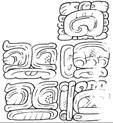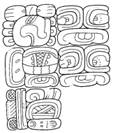
MHD.ZCH



HelmkeEtAl-ARotKV.p51.fig37c HelmkeEtAl-ARotKV.p51.fig37a HelmkeEtAl-ARotKV.p51.fig37b
NAR Altar 2 A5-B6 C1 NAR Stela 23 H4-H6 NAR Stela 46 C15-C17
NOHOL ?:na xa:ma:*na “?”:na AJ.sa{‘al} NOHOL ?:na xa.<ma:na> ?:na AJ.<sa:*li> NOHOL ?:na xa.<ma:na> ?:na AJ.<sa:li>
![]()
![]()
MHD MHD
NAR Stela 46 C4 NAR Stela 46 C13
?:na ti.<?:na>
![]()
![]()
MHD.ZCK.1&2 T351


M&G.p88.pdfp88.#3 M&G.p96.pdfp96.#4
<?:{y}OHL:K’INICH>.<SAK?:WITZ:?> <?:na>.<{y}OHL:K’INICH >
· MHD distinguishes two different glyphs – ZCH and ZCK:
o ZCH (17 hits in “Classic – Blocks”):
§ Main part:
· KAWAK+KAWAK (5 hits).
· KAWAK+TE’ (1 hit).
· TE’+KAWAK (4 hits).
· TE’+TE’ (2 hits).
· Unclear (5 hits).
If most of the unclear instances are treated as two KAWAK’s, then one could say that most the ZCH’s are two KAWAK’s. However, it might be better to say that this is an insignificant variation on two KAWAK’s.
§ Two vertical filaments running between the two KAWAK’s:
· The left one going to the left (above and below the left KAWAK).
· The right one going to the right (above and below the right KAWAK).
§ A na underneath: all 17 instances have a na underneath.
There is only one instance in the 17 where there are no filaments below the two KAWAK’s, but overwhelmingly, there are filaments below the two KAWAK’s. In the case of the exception, it could be that the na covers up the filaments at the bottom.
o ZCK (33 hits in “Classic – Blocks”):
§ Main part:
· KAWAK+KAWAK (1 hit).
· KAWAK+TE’ (5 hits).
· TE’+KAWAK (3 hits).
· TE’+TE’ (0 hits).
· Unclear (24 hits).
With considerable variation but with so many unclear instances, it might be better to say that this is an insignificant variation on two KAWAK’s.
§ Two vertical filaments running between the two KAWAK’s:
· The left one going to the left (generally only above the left KAWAK, not below).
· The right one going to the right (generally only above the right KAWAK, not below).
§ An OHL underneath: almost all 33 instances have an OHL underneath.
There is only one instance in the 33 where there is no OHL below the two KAWAK’s. There are 4 instances of filaments above and below the two KAWAK’s, but overwhelmingly, there are no filaments below the two KAWAK’s. However, it’s not advisable to class these four as ZCH because they have an OHL underneath, rather than a na.
The term “filament” is adopted from one of the major epigraphers – Martin(?). In the instances of ZCK with no filaments below the two KAWAK’s (i.e. almost all of them), it might be better to view them as internal bolding of the boulder outline than as separate “filament” elements in their own right. However, for the sake of uniform terminology between ZCH and ZCK, I will continue to call them “filaments” (they need to be thought of as that in the 4 instances of ZCK where they are present below the two KAWAK’s).
· MHD: Sometimes unclear distinction between ZCH and ZCK.
· Sim: there is a very strong correlation of the glyph after ZCH/ZCK:
o na underneath, main glyph has filaments underneath it: ZCH.
o OHL underneath, main glyph does not have filaments underneath it: ZCK.
and for both ZCH and ZCK (concluded by visual scanning) with random variation between KAWAK+KAWAK’s, KAWAK+TE’, TE’+KAWAK (and also TE’+TE’?). The presence or absence of filaments underneath strongly correlates with ZCH and ZCK (respectively), but should not be treated as a distinguishing characteristic.
· In a nutshell: ZCH occurs in writing the name/title in connection with “south and north ZCH” while ZCK occurs in writing the name/title connected to the “K’an” rulers of CRC. However, there is one example that indicates that the differences between the two might be due to regional or time-related differences, and that both ZCH and ZCK are actually the same glyph. That example is, namely, M&G.p96.pdfp96.#4 – an instance of the name of “K’an” III. (Note that “K’an” is in quotes as this is not a decipherment of one of the glyphs writing his name/title. Instead, the “K’an” is simply a nickname based on the Yucatec day-name for the 4th Tzolk’in month (written inside a blood-cartouche) which has the form of the OHL/WAAJ logogram.) In any case, this instance of “K’an” III’s name combines the characteristic features of ZCH and ZCK, in the sense that it has no filaments underneath, and yet has a na underneath. The fact that this parallels the names of “K’an” I & II, with the Yohl K’inich following in all three “K’ans” shows that ZCH and ZCK are in fact the same glyph, which I have given the nickname “TKWF” = “Two Kawaks with Filaments”. For the rest of this entry, I will refer to “TKWF” and mean either ZCH or ZCK. As already shown, “TKWF” can have two KAWAKs, or a KAWAK and TE’ (with either KAWAK or TE’ on the left). When it is in the order KAWAK + TE’, then what distinguishes it from the logogram KAL is the presence of filaments between and above them (and optionally below) and an optional na after. I.e. do not confuse “TKWF” with the “two-boulder” variant of KAL (ZCJ):
o ZCJ always has KAWAK+TE’: no variation – it’s never KAWAK+KAWAK, TE’+KAWAK, or TE’+TE’.
o ZCJ never has filaments: not between or above, let alone below.
|
|
|
|
TOK.p36.r1.c3 KAL(.TE’) |
MHD.ZCJ KAL |
When a ma is present (which is very often the case), this is read as kaloomte’. And even when a ma is not present, it is also often read as kaloomte’, presumably from context.
· Statistics of ZCH vs. ZCK:
o ZCH. A large proportion of all the known instances of ZCH occur in NAR, but also in AGT, BPK, EKB, and CML. Of the 17 hits for “blcodes contains ZCH”:
|
Site |
# of occurrences |
|
AGT |
2 |
|
BPK |
4 |
|
CML |
1 |
|
EKB |
2 |
|
NAR |
8 |
o ZCK. An overwhelming proportion of all the known instances of ZCK occur in CRC, but there is a small handful at MCW, NAR, REJ. Of the 33 hits for “blcodes contains ZCK”:
|
Site |
# of occurrences |
|
CRC |
29 |
|
MCW |
1 |
|
NAR |
2 |
|
REJ |
1 |
· “TKWF” (in its ZCH form) occurs in the combination nohol “TKWF” xaman “TKWF” in a number of different inscriptions – many from NAR (in particular NAR Altar 2, NAR Stela 23, and NAR Stela 46) and on the Komkom Vase.
· Usages differences of ZCH vs. ZCK:
o In the case of ZCH it’s unclear if these references are to historical human beings or to deities. But the belief that they are titles for individual humans is supported by the fact that in the Komkom vase, they are summoned to a meeting. Furthermore, on NAR Stela 23, they accompany K’ahk’ Tiliw Chan Chaak in what was probably a military exploit. While this doesn’t exclude the possibility that they are deities (effigies of deities were taken into battles), it does lend a little support to the idea that they are probably office holders in K’ahk’ Tiliw Chan Chaak’s administration. Yet a third possibility is that South and North <“TKWF”> might refer to two groups of individuals, i.e. further qualified as being “South” or “North” <“TKWF”>’s.
o In the case of ZCK it’s clear that most of these references are to one of the historically known rulers of Caracol: K’AN I, K’AN II, K’AN III. In fact, of the 33 hits in MHD, 32 of them refer to K’AN I, K’AN II, or K’AN III.
· Pronunciation:
o HelmkeEtAl-ARotKV.p50.pdfp50.fig36 (2018) refers to this glyph as T351v (“v” for variant) and seems to treat ZCH (fig36b&c) and ZCK (fig36a) as being variants of the same glyph.
o Stuart-ACS.5-6 (2019) discusses the capture of two individuals by Tum Yohl K’inich of CRC, but the reading in this case is uncontroversial as it refers only to the syllabogram-only spellings tu-mu of CRC Altar 23.
o Sergei Vepretskii (Moscow, workshop during conference “XXI Sergeev’s Reading”, 2019):
§ The meaning is related to the sound of striking one object against another.
§ In iconographic origin, this logogram represents the coming together of two rocks (or a rock and some wood), creating a crashing noise tum.
o BeliaevEtAl-PAEdPF6.p197.pdfp206 (2020) transliterates it as TUM. This Is the only source I’ve come across which attempts to give this logogram a reading. This may be because BeliaevEtAl believes that “TKWF” and tu-mu are substitutions in the name/title of the same individual (or of two individuals with the same name). This might be based on Ruler 8 vs. Ruler 2, Ruler 5, Ruler 12 of CRC.
· But Yohl K’inich (Ruler 8) is a different ruler from “Kan” 1, “Kan” 2, “Kan” 3 (= Ruler 2, Ruler 5, Ruler 12 / M&G.p86.pdfp86.#4, M&G.p88.pdfp88.#3, M&G.p96.pdfp96.#4 respectively). In particular, there is no certainty that the first part of his name/title is the same as that of “Kan” 1, “Kan” 2, “Kan” 3, even though all four have Yohl K’inich as the last part of their name/title – i.e. we cannot be sure that the tu-mu syllabogram-only spelling is a substitution for the logogram “TKWF”. If that were the case, then:
o “Kan” 1 would become Tum Yohl K’inich I.
o Ruler 8 would become Tum Yohl K’inich II.
o “Kan” 2 would become Tum Yohl K’inich III.
o “Kan” 3 would become Tum Yohl K’inich IV.
But M&G have kept Ruler 8 different from the other three (and kept their names as just “Kan”), precisely because we cannot be sure that there is a valid substitution.